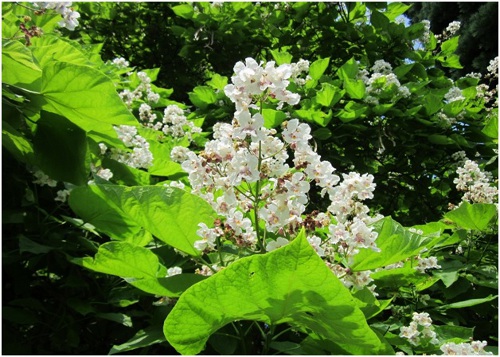Catalpa
Catalpa is a genus of flowering trees and shrubs in the family Bignoniaceae. There are several species of catalpa, including Catalpa bignonioides, Catalpa speciosa, and Catalpa ovata. These trees are known for their large, showy flowers and distinctive, heart-shaped leaves. They are native to North America and are commonly planted as ornamental trees in many parts of the world.

Catalpa Species
Catalpa species are deciduous trees that are native to North America and parts of East Asia. There are several species of Catalpa, including the southern Catalpa, the western Catalpa, and the northern Catalpa, which is also known as the cigar tree. These trees are known for their large, heart-shaped leaves, fragrant flowers, and long, bean-like seed pods.
Aside from their aesthetic appeal, Catalpa trees provide a range of ecological benefits, including providing habitat and food for wildlife. In this article, we’ll explore the ways in which Catalpa species support a variety of wildlife and help to maintain healthy ecosystems.
Care of Catalpa species
Some general tips for the care of Catalpa species:
Planting: Catalpa trees prefer well-drained soil and full sun exposure. They should be planted in the spring season or fall.
Watering: Newly planted catalpa trees should be watered regularly until they are established. Mature trees can usually get by on natural rainfall, but may need supplemental watering during periods of drought.
Pruning: Catalpa trees can benefit from pruning to promote healthy growth and remove any dead or diseased branches. Pruning should be done in the end of the winter or early spring.
Fertilizing: Catalpa trees do not require a lot of fertilizer, but may benefit from a balanced fertilizer in the spring.
Pest and disease control: Catalpa trees can be susceptible to several pests and diseases, including catalpa sphinx moth and verticillium wilt. Proper care, including pruning and regular watering, can help prevent these issues.
Winter protection: In colder regions, young catalpa trees may benefit from winter protection such as burlap wrapping or mulch around the base of the tree.
Benefits of Catalpa Trees
There are some important benefits of Catalpa Trees are
Habitat for Wildlife
One of the most important ecological benefits of Catalpa trees is that they provide habitat for a wide range of wildlife. Their large, spreading canopies create a shady, sheltered environment that provides a home for birds, insects, and small mammals.
Catalpa trees are particularly important for cavity-nesting birds, such as woodpeckers and bluebirds, which require large, hollow spaces in which to build their nests. Catalpa trees provide these spaces, as well as a reliable source of food in the form of insects, which are attracted to the tree’s nectar and foliage.
In addition to cavity-nesting birds, Catalpa trees also provide a habitat for other birds, such as warblers, vireos, and thrushes, which use the trees for shelter and nesting sites. The large leaves of the Catalpa also provide cover for a range of small mammals, including squirrels, raccoons, and opossums.
Food for Wildlife
In addition to providing habitat for wildlife, Catalpa trees also provide a reliable source of food for a range of animals. The tree’s fragrant flowers are particularly attractive to bees and other pollinators, which feed on the nectar produced by the flowers.
The Catalpa’s large leaves are also an important source of food for a range of insects, including caterpillars, which use the leaves as a food source. These insects, in turn, provide a food source for a range of birds, including warblers and vireos.
The tree’s long, bean-like seed pods are also an important food source for a range of wildlife. The pods are rich in protein and other nutrients, and are particularly attractive to squirrels and other rodents, which use the pods as a food source throughout the fall and winter months.
Maintaining Healthy Ecosystems
The ecological benefits of Catalpa trees extend beyond providing habitat and food for wildlife. These trees also play an important role in maintaining healthy ecosystems, by helping to prevent soil erosion and improving air and water quality.
The roots of Catalpa trees are deep and spreading, which helps to stabilize the soil and prevent erosion. This is particularly important in areas where soil erosion is a problem, such as along riverbanks and other areas prone to flooding.
Catalpa trees are also effective at improving air and water quality. Like all trees, Catalpa trees absorb carbon dioxide from the atmosphere, helping to reduce greenhouse gas emissions and mitigate the effects of climate change. Additionally, the large leaves of the Catalpa help to filter pollutants from the air, improving air quality and reducing the risk of respiratory problems.
Read about: Deciduous Trees
Conclusion
In conclusion, Catalpa species provide a wide range of ecological benefits, including providing habitat and food for wildlife, maintaining healthy ecosystems, and improving air and water quality. These trees are an important part of many ecosystems, and their continued existence is essential for the health of our planet and the survival of many species of wildlife.
Whether you are a conservationist, a gardener, or simply a lover of nature, there are many ways in which you can help to protect and promote the growth of Catalpa trees. By supporting conservation
